THE SERIES
- Part 1: Build an AR-15: The Series Introduction
- Part 2: Build an AR-15: AR Calibers
- Part 3: Build an AR-15: Direct Impingement or Piston Operation
- Part 4: Build an AR-15: Tools and Materials
- Part 5: Build an AR-15: The Lowdown on Lowers
- Part 6: Build an AR-15: Intro to Uppers
- Part 7: Build an AR-15: Barrels
- Part 8: Build an AR-15: Choose The Right Buttstock
- Part 9: Build an AR-15: Choosing the Right Optic
When deciding on the perfect optic for your AR build, the very first thing you need to do is match the performance window of the optic with the performance window of your rifle. For example, installing an optic that’s optimized for 1,500-yard shooting won’t do a whole lot of good on a Cricket .22LR bolt-action youth rifle. While that’s an exaggeration, the concept of matching performance characteristics does come into play with the AR family.
One of the neat things about the AR family is the wide variety of calibers you can stuff into the same basic rifle platform. Some of these are more appropriate for longer range applications than the original 5.56x45mm. If we get into optics for all the 130 or so AR platform calibers, we’ll be here until the 2016 election, so let’s focus on the standard – the .223 Remington. Certainly, many if not all of the optics discussed here can be useful in other AR calibers like 300 Blackout or 6.8 Remington SPC.
Performance Window of the AR-15
What will the standard AR chambered in .223 Remington or 5.56x45mm NATO really do? That depends partially on the specific gun, as short barrel rifles will launch these projectiles with significantly lower velocity than 16 or 20-inch barrel rifles.
To take a very specific look at the down-range performance of the .223 Remington, let’s use an example case of very common ammo. For the ballistics numbers here, I’m using the Federal American Eagle 55-grain FMJ Boat Tail ammo.The vast majority of what people are buying and shooting with their rifles is pretty darn close in performance to this 55-grain load, so it should be pretty representative.
I’ll assume we’re shooting it from a 16-inch barreled rifle so the actual velocity will be a little less than the 3,240 indicated on the box. That most likely applies to a 20-inch barrel. I clocked the velocity of this round using a Shooting Chrony Beta Master Chronograph placed 15-feet down range and came up with an average of right about 2,900 feet per second when fired from a Smith & Wesson M&P15 VTAC.
When I plug in that velocity, using an optic mounted 2.75-inches above the bore and a 50-yard zero, I get the following ballistic table.
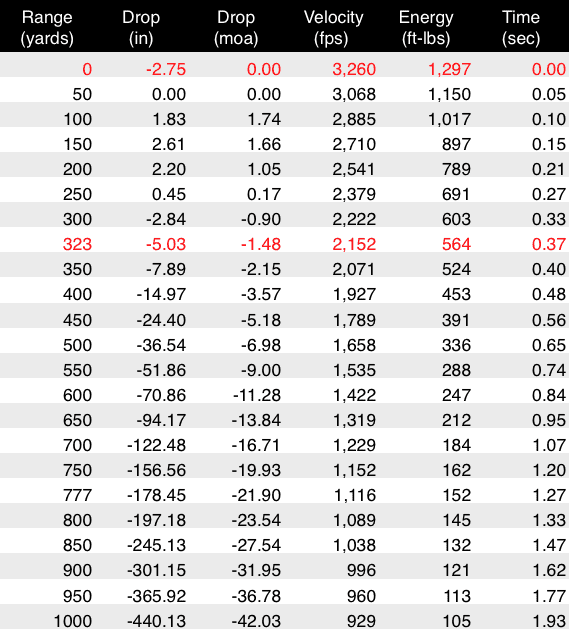
Now it’s time to play pick your numbers. If you care about energy down range, check out the foot-pounds column. At 450 yards, the .223 projectile is carrying about the same amount of kinetic energy as a 9mm pistol delivers near the muzzle. When you lob one all the way out to 900 yards, you’re roughly equivalent to a .22LR projectile. While I certainly wouldn’t want to be plugged by one at a farther range, most people tend to think of the .223 Remington being effective out to 300 or 400 yards. That makes sense as it’s still carrying a respectable amount of energy and traveling close to 2,000 feet per second. Can you hit targets farther out? Sure, but the destructive power drops off dramatically and bullet drop and wind drift get to be a real problem.
Another interesting thing that the trajectory chart tells us is that you can hold directly on a target, without compensating for distance, out to 323 yards. I have this trajectory math set up with a 5-inch threshold either way, assuming we’re aiming at a moderate size target. Given that, we can consider optics with no on-the-fly adjustment capabilities like red dots. Without the need for dials and complicated graduated reticles, we can be effective out past 300 yards.
Accuracy of the AR-15
Another factor to consider is the accuracy potential of the AR-15. While there’s an old rule of thumb that requires four minutes of angle (MOA), or shots within a four-inch circle at 100 yards, most modern AR rifles will shoot somewhere between one and two minutes of angle. That’s within 1-2 inches at 100 yards, 2-4 inches at 200 yards, etc.
I relate this because the size of the aim point in your optic of choice becomes an issue, or more accurately, a non-issue. Most red dot zero magnification optics have dots that range in size from one to three MOA. Given the average one to two MOA of the rifle itself, these dots just about cover the potential variance of the rifle from shot to shot. Cover your target with the dot, and if you do everything right, the shots will fall “inside” of whatever you cover with the dot.
The 200-yard barrier?
I like to consider the optics choice based on an admittedly arbitrary 200-yard barrier. If the gun in question will be used almost always inside of 200 yards, I’’m almost always going to choose a non-magnified optic.
Unless your intended use is precision target shooting where your targets are measured in single-digit inches, a red dot sight will give you visibility, speed and enough precision to reliably hit your target anywhere inside of this range. A red dot sight like an Aimpoint PRO or Micro has a 2 MOA dot size, so at 100 yards, that dot is only covering a two-inch circle. At 200 yards, it covers four inches. A torso target is 15 or so inches wide, so it’s relatively easy to get the necessary precision for repeatable hits.
Past 200 yards, you may want more aiming precision. For example, crosshairs in a magnified scope will cover a much smaller area of your target at 300 or more yards than most any red dot.
Most people make the mistake of over magnifying their rifle. I get it, and do the same thing, mainly because it’s fun to set up tiny targets 100 or 200 yards downrange and hit them. If that’s your intended use for your rifle, then knock yourself out and do it! If it’s to be a defensive rifle, just consider sacrificing that “precision for fun” use and going with something that will be more effective on realistic defensive target sizes. As soon as you start to magnify, the field of view through the scope becomes a very real limitation. To put some numbers on that, a 9x scope will only show somewhere in the neighborhood of 11 feet of visible area at 100 yards distance. Just finding your target, much less tracking a moving target, becomes very difficult when your visible area is limited.
Home defense?
Is it going to be a nightstand gun? If so, you really want to consider a zero magnification optic.
For a home defense gun, speed and low-light operation are paramount. These two factors also imply a need for a maximum field of view visibility. It’s hard to imagine using anything other than a zero-magnification red dot or tritium powered iron sight setup indoors. You’ll be able to shoot with both eyes open and easily see everything going on around you. Depending on your choice of red dot, the tube or frame of the optic itself also makes for a super fast close range aiming solution. When the distance is measured in feet, anything you see through the frame of your optic is going to get hit.
One exception is the 1-(whatever)x crop of AR optics on the market. These dial all the way down to 1x (zero) magnification. While at home, you can set your dial to the 1x setting and come close to the speed and field of view benefits of a red dot optic. You’ll still have some minor shadowing issues if your eye is not centered on the scope exactly, but it’s a pretty good solution. If you go this route, I would suggest getting an illuminated reticle option so it’s actually visible indoors in lower light conditions. Of course, you’ll have to remember to turn it on if ever needed for home defense.
Zero Magnification Choices
Let’s take a look at some proven red dot and holographic optic choices at various price points.
EOTech EXPS2 MSRP: $579
EOTech makes infinity plus one models, so let’s narrow things down. Unless you need night vision compatibility, the EXPS2 is a great option. It uses a common Lithium 123 battery that’s mounted sideways so it takes up less space on the rail and is more resistance to long term recoil effects. The EoTech reticles are super fast, generally consisting of a large circle for close range targeting and a one MOA dot for precision at longer ranges. It’s hard to go wrong with any of the EOTech models.
Aimpoint ACO MSRP: $393
Aimpoints relatively new Advanced Carbine Optic (ACO) shares many of the same features as the popular Aimpoint Patrol Rifle Optic (PRO) but is simplified to meet a lower price point. The fixed mount is optimized for AR rifle placement and height. Like the PRO and Aimpoint Micro models, the ACO is designed to be an “always on” optic, which is one of the reasons I like them so much. As a home defense or LE option, it’s ready to go with no need to remember switches and settings. You can turn it off, but if you change the batteries once a year, you never need to.
Vortex Strikefire II MSRP: $239
This one comes with a cantilever mount that’s perfect for AR use. The four MOA optic is also available in red dot only or red and green dot combination models. While it’s not an “always on” design, it does feature an automatic shutoff to help preserve battery life. It’s a great value as you can find them for well under $200 on the street.
The minis!
There’s a whole slew of “micro” red dot optics on the market. These are lower profile but can be used as your primary optic, or angle mounted in conjunction with a magnified scope for short range use. Just give the rifle a 45-degree twist to sight using the secondary mini red dot. The Warne RAMP mount is a great solution to mount both a scope and mini red dot sight.
In this category, check out the Leupold DeltaPoint and Burris FastFire.
Magnified Scope Choices
If you want to magnify, you’ll find a universe of potential scope options. Perhaps the most important consideration is to make sure your optic and mount will coexist happily on your rifle. On the AR, you have to take into consideration a relatively short receiver mounting area and the fact that the charging handle is located right where the ocular lens wants to be. Using a traditional scope with traditional rings might result in a configuration where you have to mount the optic too far back, which puts it too close to your eye and right over the top of the charging handle. For this reason, I really like the purpose-built one-piece cantilevered scope mounts like the Warne RAMP. The base will fit on the receiver rail segment while the rings are thrust forward. This allows you to place the scope in a more natural position.
Also, given the limited effective range of the AR, at least in .223 Remington / 5.56×45 NATO, be careful not to over-magnify unless you have a specific reason for doing so. As little magnification as 4x will allow you to easily hit targets at 500 yards without adversely impacting your field of view. While you can reach a target at the outer range of the .223 cartridge with 4x, it’s nice to have 6.5 or even 8x at your disposal. Of course, if your game is small varmint hunting, you may want even more magnification since your distant targets will be small.
Here are a few of my favorite magnified scopes for the AR.
Trijicon ACOG 3×24 MSRP: $1,285
I picked this particular ACOG as the 3x fixed models are my favorite, but the 2x and 4x models are surprisingly effective at longer distance too. The simplicity of a fixed low power optic really grows on me the more I shoot it. The 3x models are low power enough to use at indoor distances if necessary, but magnified enough to give you surprising precision at distance. ACOGs aren’t cheap, but you get what you pay for. With most models having some form of dual illumination, they’re going to work, period. The one I’m currently using is fiber optic and tritium lamp powered, so the reticle is always lit, in day or night conditions. No batteries or switches, it’s just there. I’m really getting spoiled with this one.
Bushnell Elite Tactical SMRS 1-6.5x Street Price: ~$1,100 depending on model.
Quality magnified optics aren’t cheap. Besides the quality of the glass, one of the things that drives price is a first focal plane reticle. Without getting too much into the weeds, a first focal plane reticle grows and shrinks with the zoom setting. This is important because the hash marks maintain their same meaning at any magnification level. If your reticle has ranging features, they work at any magnification. If it has ballistic drop compensation holdover marks, they are accurate at any power setting. With second focal plane (and less expensive optics), those features only work properly at one power setting. That’s what you’re paying for.
I like the Bushnell Elite Tactical SMRS series because the illuminated reticle works like a red dot at the 1x setting, while allowing precise holdovers at higher zoom levels. It’s also built like a tank.
Nikon M-223 1-4×20 BDC 600 MSRP: $299.95
It’s hard to go wrong with any of the models in the Nikon M-223 series. The glass is excellent and it’s hard to beat the price value. This particular model features 1-4x zoom. The ballistic drop compensation reticle has circles and marks that indicate hold points from zero to 600 yards in 50-yard increments.
Burris MSR Riflescope 3-9×40 MSRP: $239
A great value on a general purpose MSR optic is this Burris MSR model. 3-9x magnification is about as versatile as you can get and introduces you longer varmint hunting range. It’s got a BallisticPlex reticle so you can easily translate reticle marks to your ammo of choice. If you’re into prairie dog hunting, check out the 4.5-14×42 model.
Iron Sights?!
Iron sights are still around for a reason, so don’t discount those as a primary option too quickly. For an AR rifle, they can certainly serve as your primary sighting tool. They’re also great as a backup option in case your magnified or red dot optic cries uncle. You’ll also find them on tricked out competition rifles mounted alongside a magnified optic, but at a 45-degree angle, so they can be used with a slight twist of the rifle for close targets.
If you choose to go the primary route, I would urge you to consider adding a little bit of healthy radioactivity to your rifle. As a primary sight, it sure would be helpful to have visibility in low light conditions, right?
Check out the AR platform options from XS Sights. You can start with a simple tritium powered post that replaces your current front sight post only. The post only option that uses your existing sight base is about $60 and comes in a dot or vertical line configuration. Or, you can get a front and rear set in different combinations of non-illuminated or tritium rear sights.
Closing thoughts
The most important takeaway is that your rifle is only as good as your optic choice. It’s ever so tempting to put all the AR build budget into the rifle itself, but without a quality optic, the ability to hit targets consistently, in any environment, and for the long haul, is severely compromised. It’s not at all unusual for serious AR shooters to spend as much on their optic as the rifle itself. Less serious shooters might consider spending half the cost of the rifle on the optic solution. It’s that important.
Part 1: Build an AR-15: The Series Introduction
Part 2: Build an AR-15: AR Calibers
Part 3: Build an AR-15: Direct Impingement or Piston Operation
Part 4: Build an AR-15: Tools and Materials
Part 5: Build an AR-15: The Lowdown on Lowers
Part 6: Build an AR-15: Intro to Uppers
Part 7: Build an AR-15: Barrels
Part 8: Build an AR-15: Choosing the Right Butt Stock

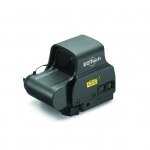
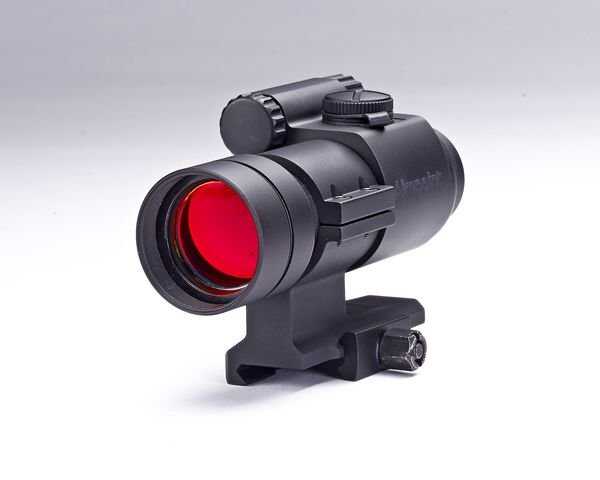
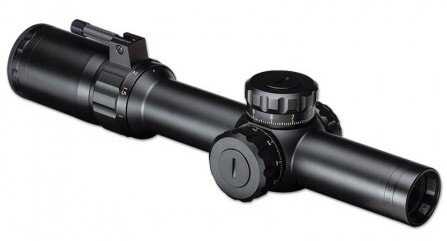
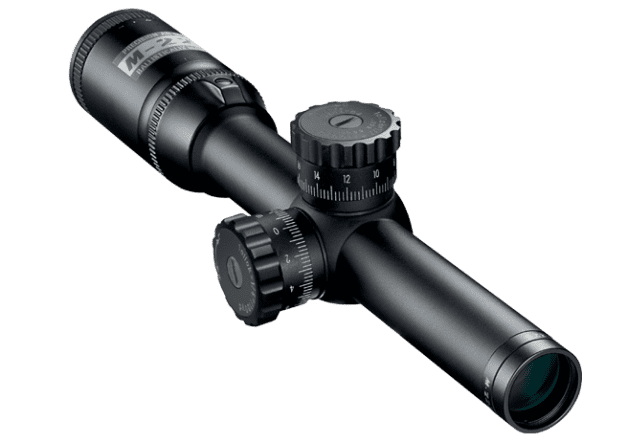

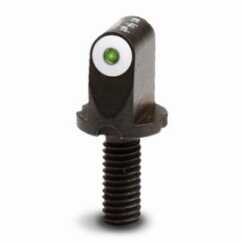
Nice summary. I use the AIMPOINT PRO on my 16″ carbine (5.56), and a Vortex PST 1-4x on my 6.8SPC hog rifle. The vortex is nice because it has an illuminated reticle which is still easily visible even with battery failure, so I don’t worry about a backup system with it. Just get your target inside the “box” and you’ll hit it. I have a 4-12x magnified scope when I switch my 5.56 to a 20″ varmint barrel. Seems to fit my purposes nicely. As a backup sight, I use the See All site on a 45degree offset ramp mounted immediately in front of the magnified optic. For $99, it’s also a nice option which allows you to keep both eyes open.